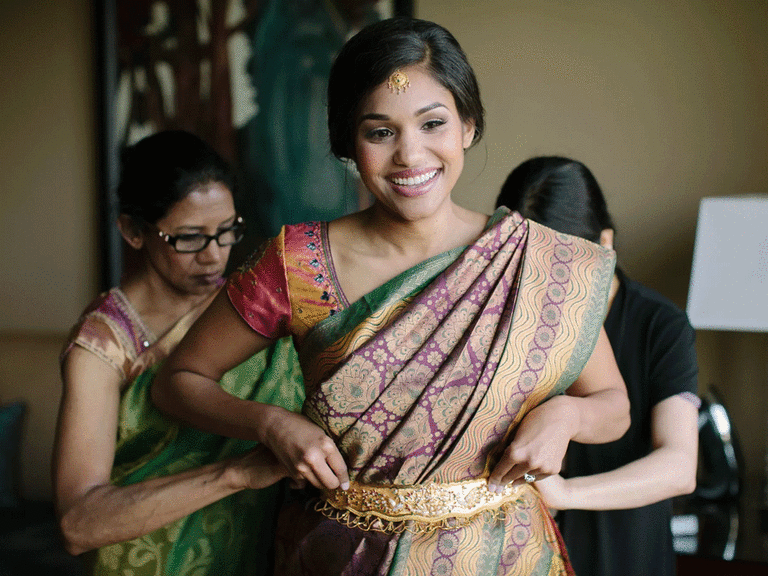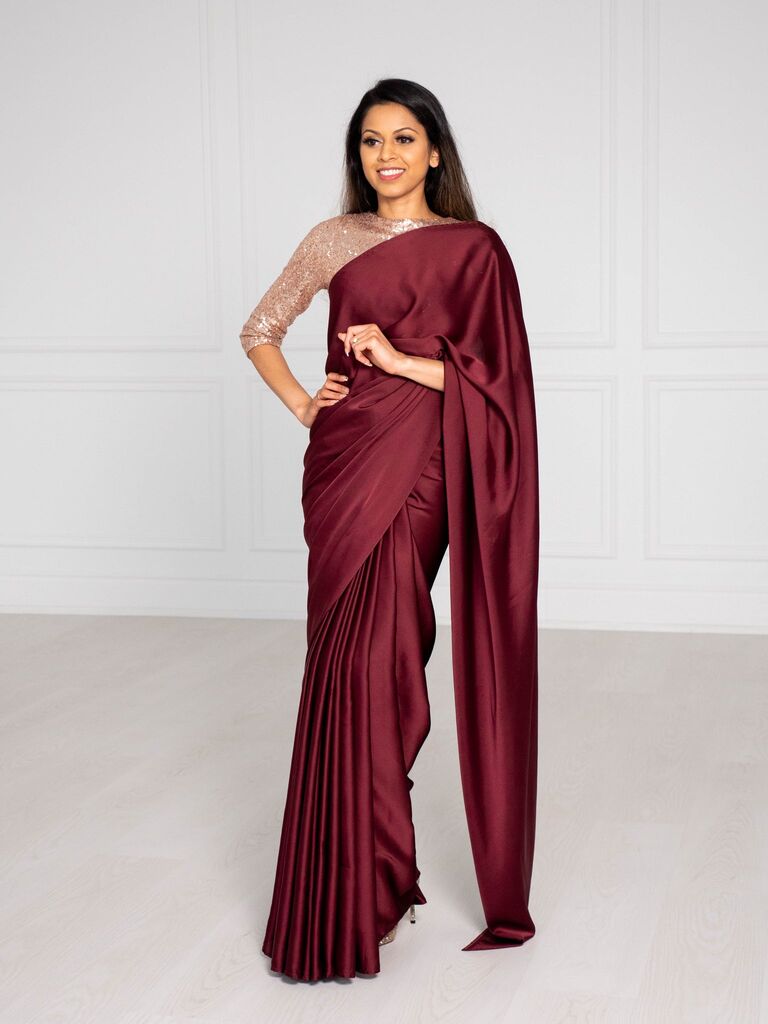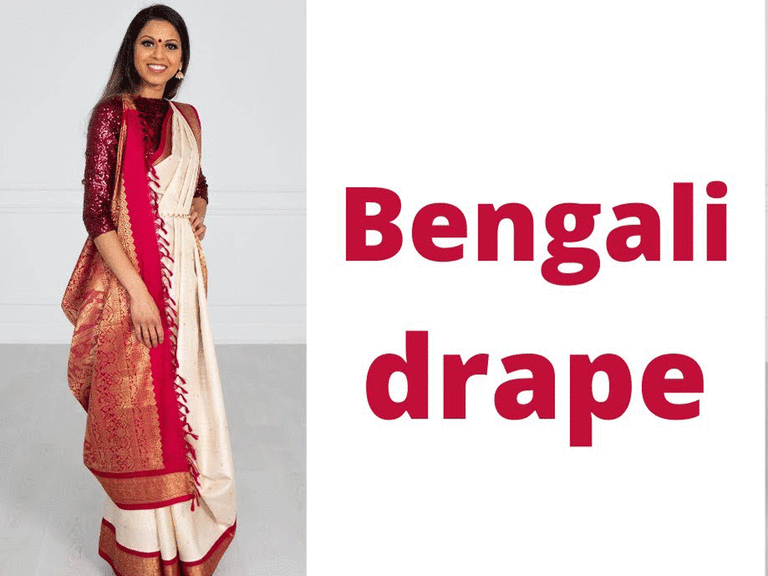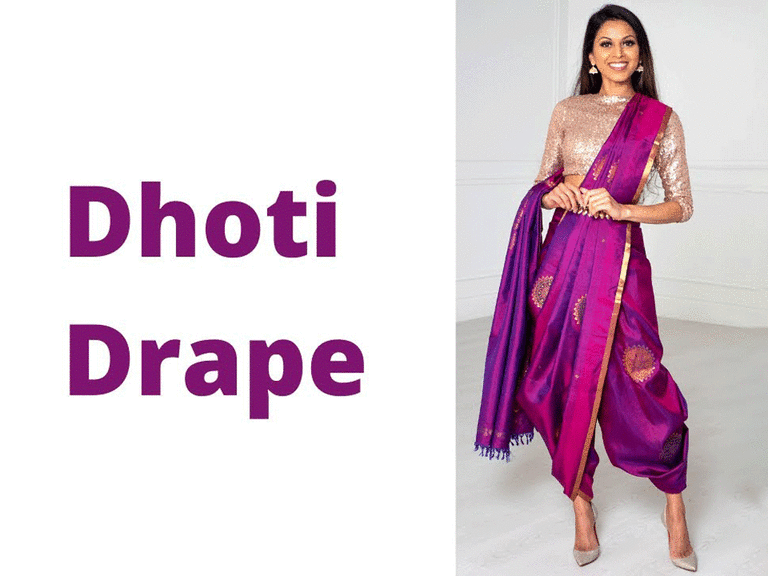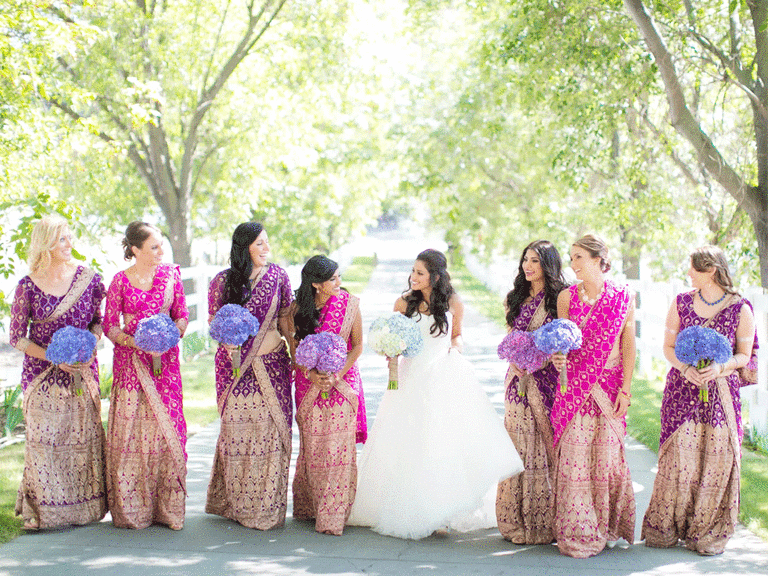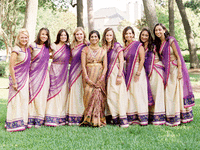4 Easy Saree Draping Styles You Should Know for South Asian Weddings
Sarees, alternately spelled saris, are beautiful garments packed with extensive history and culture in each fiber. If you're attending an Indian wedding or a South Asian wedding as a guest, you may get the exciting opportunity to wear a saree. And if you've recently looked up, "How to drape a saree for beginners," then you need saree draping styles to try for your event. Read below for tips from saree experts and step-by-step guides to the most popular drape styles that'll impress the to-be-weds and other wedding guests.
In this article:
- How to Make a Nivi Drape With Hanging Pallu
- How to Make a Bengali Drape
- How to Make a Dhoti Saree Drape
- How to Make a Mermaid Drape
- Six Tips for Draping Your Saree
How to Make a Nivi Drape With Hanging Pallu
The nivi drape is one of the most popular saree draping styles at Indian weddings because it's the simplest to do, which makes them great for beginners. "The nivi drape is the one I feel if you were to Google sarees, that's the drape that will come up. The nivi drape is a safe drape to do because it's so popular," Tia Bhuva, founder of Tia Bhuva.com, says.
Supplies: A saree, underskirt, choli and safety pins
While holding one end of your saree, neatly tuck the top edge of the saree into your underskirt (ensure the drawstring is tight)––starting from your right hip and ending a few inches to the right of your belly button. Make sure your saree is at a height where it's lightly grazing the floor.
-
Grab the other end of your saree, then guide it behind you and back to the front.
-
Gently toss the end of the saree over your left shoulder to create a pallu, which is the loose end of a saree that's worn over one's shoulder or head. You want the pallu to hit the back of your knee. At this point, you should look like you're wearing a toga.
FEATURED VIDEO FROM THE KNOT Gather all the fabric that's resting on your left arm and place it on your left shoulder.
Take the edge of the pallu that's closest to your chest, then pull it tight around your body and bring it back in front.
-
While keeping the saree edge tight, use your other hand to pinch all of the layers underneath the top layer, which includes the underskirt, together so you can pin everything to your upper right thigh. Now, you have a loop in front of you.
Take the edge of the saree closest to you and place your right hand a few inches from where it's tucked on your right side. Have your fingers and pinky facing away from you while your thumb is tucked inside the saree's edge. This is the base to make your pleats.
-
Use your left hand to guide the fabric back and forth between your pinky and thumb until all of the material is pleated. Once you're done, remove your pinky. (To elevate your nivi drape, slightly stagger the top ends of your pleats like a staircase pattern.)
Move a few inches below the top ends of your pleats and pin it a little to the right of your belly button, so your pleats are centered, to secure it to your underskirt. Tuck the extra fabric at the top into your underskirt.
Take the fabric off your left shoulder, open it up and bring it around your body so you can wrap the fabric over your chest like a dress. Gently place the rest of the fabric on your left shoulder.
-
Add a safety pin at the back of your left shoulder or the bottom of your choli to secure your pallu and choli together. This way your pallu doesn't fall. (A choli is a fitted blouse that's commonly cut at the midriff area.)
How to Make a Bengali Drape
Fun fact: Many saree draping styles are specific to different regions of India and other parts of South Asia. This is true for the Bengali drape, usually seen at weddings where Southern Indians are in attendance. "A Bengali drape is a traditional favorite of Bengal that flaunts an overturn drape. In recent years, married women from Bengal are seen in this drape style during weddings or main festivals like Durga Puja," Rumela Sen, the lead editor at WeddingWire India, explains.
Supplies: A saree, underskirt, choli and safety pins
Take the edge of your saree and drape it over a table so you can start the pleating process.
-
Decide on the width of your pleat and use both hands to fold over your first pleat.
Pinch the fabric around the same width (it doesn't have to be perfect) to create another pleat. Do this until you've reached the other end of your saree. Every time you complete three pleats, pin both ends of the pleats to ensure security.
A Bengali drape has a long pallu, so extend the pleats you've made by moving down a forearm's width away from the innermost safety pin from step three. Make about six pleats and pin them together at the end.
-
Put the pallu over your left shoulder, it should be grazing the floor, then take out the safety pin at the bottom of the pallu.
Take the innermost corner of the bottom of the pallu and put it on your right shoulder. Look behind you to see if you like where the drape falls, it should look like a cowl neckline on a dress. Adjust your pallu length to your liking, then put a pin in the pallu. This is where you'll eventually pin it to your choli.
While holding one end of your saree, neatly tuck the top edge of the saree into your underskirt (ensure the drawstring is tight)––starting from your right hip and ending a few inches to the right of your belly button. Make sure your saree is at a height where it's lightly grazing the floor.
Pick up the pallu and place it on your left shoulder. Ensure the safety pin used at the end of step six is in the correct spot.
-
Pleat the extra fabric by folding it left to right, then tucking it into your underskirt.
When you reach a point where you can't pleat the fabric anymore but have enough left to tuck, space out your pleats on the shoulder part of the pallu. Then take the edge of the fabric and tuck it into the back of your underskirt.
Take out the rest of the safety pins in the pallu, except the one on your left shoulder, then grab the end corner of the pallu and pin it to your choli on your right shoulder.
How to Make a Dhoti Saree Drape
There are two options for guests for the dhoti drape. You can get a pre-stiched dhoti saree or drape the dhoti style the traditional way. Sen recommends using a lightweight georgette saree or cotton saree for this Indo-Western saree draping style. Khushi Shah, creative director for Shanti Banaras, offers a helpful style tip for wedding guests. "Wear your saree in a half saree drape over dhoti, palazzo pants or even over leggings. Pair a chic and fancy blouse over it."
Supplies: A saree, leggings (optional), choli and safety pins
Take the edge of your saree and drape it over a table so you can start the pleating process.
Decide on the width of your pleat and use both hands to fold over your first pleat.
-
Pinch the fabric around the same width (it doesn't have to be perfect) to create another pleat. Do this until you've reached the other end of your saree. Every time you complete three pleats, pin both ends of the pleats to ensure security.
Take the saree and bring it behind you so two-thirds of the saree, including the pallu, is on your right and the rest of the saree is to your left. The step is necessary and needs to be correct, so the leg proportions made in steps six and seven are perfect (or close enough).
-
Grab the top parts of the left and right sides of the saree, tie them together and make a tight knot. This step is why leggings are optional since you tuck the rest of the fabric into this knotted area.
Take the left end of the saree, the one without the pallu, and wrap it around your left leg so it's completely covered and bring the end back to the front.
Take the edge of the saree closest to you and place your right hand a few inches from where it's tucked on your right side. Have your fingers and pinky facing away from you while your thumb is tucked inside the saree's edge. This is the base to make your pleats.
Use the bottom of that left side and create pleats with the fabric. Take your left hand to guide the fabric back and forth between your pinky and thumb until all of the fabric is pleated. Once you're done, remove your pinky and tuck the top of the pleated section into the back of your saree (or leggings) in the middle.
-
Grab the right side of your saree, so the pallu is facing the way it would be if you were placing it on your left shoulder, and wrap it under your right leg without twisting it.
Ensure the pleats in the pallu and leg area are neat, place the pallu on your left shoulder and pin it to your choli.
How to Make a Mermaid Drape
Want to know how to drape a saree in another unique style? Try the mermaid saree drape. It's ideal for people who want to look taller since the saree is draped in a way that hugs and elongates the body. This style is best when using nine yards of saree fabric. Shah provides advice for the mermaid drape guide below.
Supplies: A saree, underskirt, choli and safety pins
Tuck the non-pallu end of the saree on the right side and bring it over the waist to the back side and tuck it in fully into your underskirt (ensure the drawstring is tight)––starting from your right hip and ending a few inches to the right of your belly button.
Take the other end of the saree and tuck it on the left waist, leaving some fabric free.
Wrap the rest of the fabric behind you, take the edge of the saree closest to you and place your right hand a few inches from where it's tucked on your right side. Have your fingers and pinky facing away from you while your thumb is tucked inside the saree's edge. This is the base to make your pleats.
Make pleats using your left hand to guide the fabric back and forth between your pinky and thumb until all of the fabric is pleated. Once you're done, remove your pinky and add a safety pin to the top part of the pleated pallu.
Place your pallu upside down on your right shoulder. You should have a cowl on your back left side and a small "pouch" of fabric in the front.
Do two to three pleats with the small "pouch" of fabric, tuck it into your underskirt under your belly button and pin it all together.
Grab the left corner of the pallu in a single layer, drape it around the left waist, tuck it below the left waist and pin it all together.
Pin the top of the pallu to the right shoulder of your choli.
Six Tips for Draping Your Saree
Now that you know how to put on a saree in four beautiful styles, check out these helpful tips for the draping process. You'll be a saree draping pro in no time.
Have your drape style match your saree's fabric and length.
Before choosing your saree drape style, make sure it fits your saree's fabric and length. "Your overall look will also depend on the blouse design you pair your saree with. For example, if you're keen to flaunt a butterfly saree drape style, opt for a saree with nice and broad borders that can add an edge to your pallu look. Style it with a deep-back neck blouse design for the perfect Bollywood vibes," Sen says.
Practice draping your saree before the wedding.
Depending on the drape style, learning how to drape a saree can be simple. But don't wait until the wedding day to try your draping techniques. "I think that it's easy to do it yourself. That's if you practice and it's not the first time. The morning of your event should not be the first time you're practicing draping the saree," Bhuva says. Sen suggests getting help from loved ones if you can. "It would be easier to get some help either from someone in the family who wears a saree more often or from an expert in draping. The latter is recommended if you're trying a more traditional draping style or a more advanced style like a double saree drape."
Don't be afraid to use safety pins.
You might think that using safety pins to secure your saree is frowned upon since it's not the traditional method, but don't hesitate in using them. "Everyone wears safety pins. So if you look at how grandmas drape sarees, they did not use safety pins. They use tucks and knots to keep all the pleats and drapes intact. But in the last 50 to 70 years people started using safety pins. Now nobody is draping a saree without a safety pin," Bhuva says.
But don't use safety pins excessively, especially if you're wearing a passed-down saree that you want to preserve. "You don't want to put holes in your grandma's super ornate silk saree. For this situation work with the saree's base using as few pins as possible. Use the waist chain, brooches or other clips to keep everything in place.
Wear your wedding shoes while draping.
Put on your footwear while practicing draping and on the wedding day. By doing so, your saree won't be too short or too long but instead fit the height you'll be on the day of the event.
Choose a lightweight saree fabric.
Lightweight sarees are best for beginners trying saree draping styles because it makes it easier to pleat and drape. Also, lightweight fabrics are great for weddings during the warmer seasons. When you eventually increase your skill level, you can work with a heavier saree with lots of embroidery.
The Knot Expert Tip: Don't forget to iron your saree before draping since it makes the garment easier to manipulate.
Research where your saree is from.
"Get to know about your saree and the drape you're wearing. Even a simple Google search to understand it a little before you wear it is good. And it's not to show off and to be like, 'I know everything.' It's for your own intention and knowledge as well." Wedding guests showing appreciation for their saree during their draping journey helps preserve its culture. "We've preserved the saree draping traditions but it's also been molded and changed. Regardless, the traditional draping styles have stood the test of time. And I'm not saying I want to freeze it the way it is. But I want to make sure that we continue to evolve with it while keeping the foundation on this garment that's been around for many years and generations," Bhuva says.
